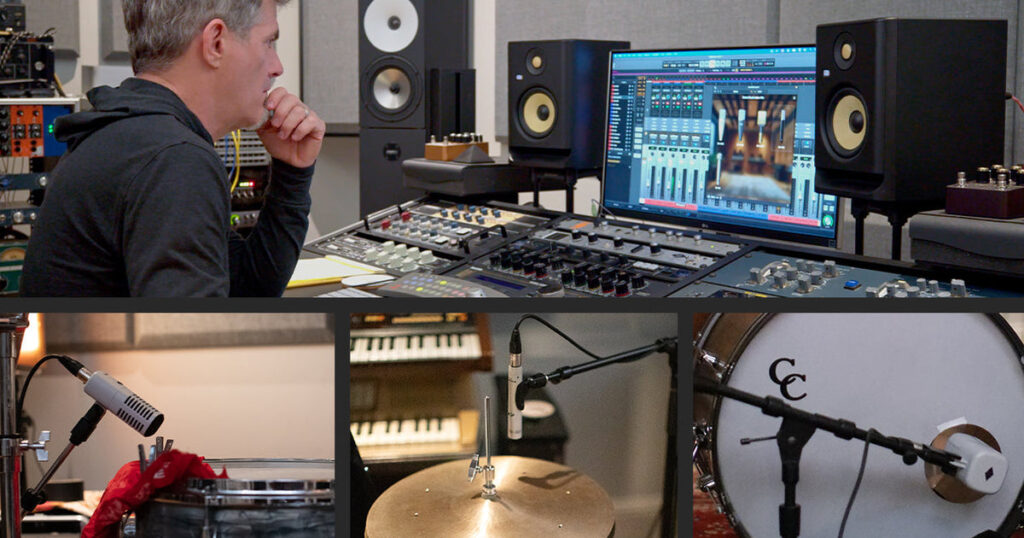Learn How Grammy-Winning Producer Jacquire King combines UA Modeling Mics, an unconventional kit, and dialed-in placement to recreate the essence of OG Hip-Hop drum tones.
In this Modeling Microphone Masterclass, Jacquire King brings the grimy vibe of drum-machine driven hip-hop to the acoustic realm with the help of session musician Logan Todd. Emulating the crisp and clear samples of early genre-defining albums, King employs an out of the box approach to create those iconic electronic percussion sounds with the feel and energy of a real drummer.
Eclectic Acoustic Drum Kit
As is the case with anything you put a microphone in front of, a great recording starts with the right source. With sounds in the room as close to the final product as possible, less processing is needed in the mix stage. Aiming to recreate synth-esque drum tones with a real pair of sticks, Todd employs a diverse mix of percussion instruments and dampening techniques to create a quirky genre-specific kit.
Beginning at the center of the setup, he opts for a suitcase paired with a traditional kick-drum pedal to recreate the enhanced low end thump needed for the genre. Flanked by a pair of Congas and a Pandiero drum, Todd muffles with a combination of tape and towels to recreate the pitched percussion and bass sounds of the infamous Roland TR-808. The most traditional part of the kit is a shallow snare drum, tuned high and lightly muffled to create plenty of snap and a cutting tone.
Thoughtful Placement
The bulk of the drum sound on this recording is coming from a single mic. Aiming to capture the kit with a balanced full picture, King opts for an SC-1 Condenser Microphone out front. Placed close to the drum kit, the sensitive condenser is positioned to capture the tone of the kick, snare, and additional percussion while controlling cymbal bleed for a natural blend. When capturing the majority of your sound with a single microphone, the first position you try may not always be ideal. Don’t be afraid to adjust your position to achieve the right balance of shells, attack, and cymbal wash.
Second to a great sounding source, getting the right microphone placement is the next most important part of properly capturing your track.
Supplementing the single microphone sound with additional options wherever needed, King sets up a handful of extra options. On the suitcase kick, an SD-5 Dynamic Microphone is the perfect choice to add low-end punch. Another SC-1 takes the place of spot mic on the Congas for extra presence. On snare King goes with an SD-7 Dynamic Microphone, taking advantage of the hypercardioid pickup pattern to reject bleed. This allows for a further placement from the drum to help capture the shell and snare wires to create a fuller picture. Finally, he places an SD-3 Dynamic Microphone on the hi-hats to impart them with a crunchy mid-range presence.
Notably, not a single overhead or room mic is deployed for this session. While they can be an essential part of most drum sounds, capturing the cymbals and adding depth to the overall mix, that isn’t what’s needed for this setup. Instead, opting to forgo them entirely keeps the tones up front, focused, and aggressively punchy.
Microphone Model Selection

Paired with the Hemisphere plug-in, UA standard series microphones have access to emulations of go-to recording classics.
For the highly characterful sound of Lo-Fi drums in the acoustic world, microphone selection is everything. That’s why modeling mics are a perfect companion for this application. Paired with the Hemisphere Mic Collection plug-in, these UA Modeling Microphones allow King to shoot out a slew of different emulations of classic options. Better yet, all after recording.
For the main front of kit mic, the LD-47K wins out over the competition for its inherently smooth sound. Providing extra weight and a controlled top-end to the entire kit, it’s the perfect choice for Lo-Fi tone. For the kick, the DN-SUB adds extra oomph. On the Conga, the LD-103 adds air and brightness. The DN-545 brings a perfectly chunky vintage flavor to hats, and the DN-441 is the perfect companion to a bright popping snare sound.
As a bonus, the SC-1 perfectly captures a bass overdub. Using the LD-47K model once again grabs the full tone and dynamic range of the bass cab without any additional harshness. Paired with an Ampeg and P-Style bass, it slots perfectly into place for this track.
Want to hear more microphone models in action? Check out the full Modeling Microphone Masterclass playlist.
– UA Staff
Related Articles:




